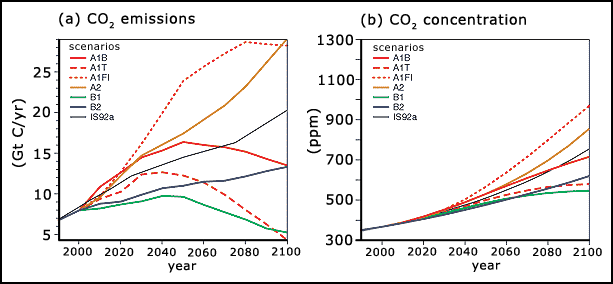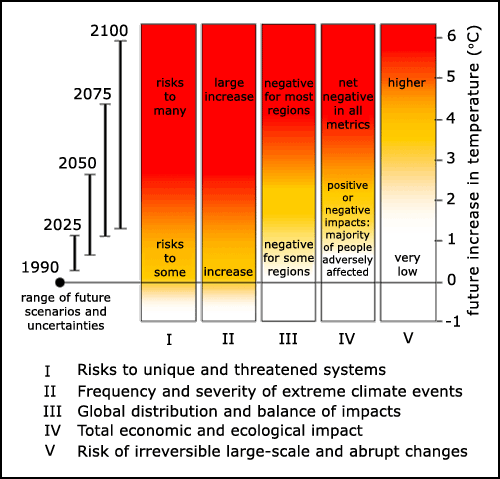


This page will describe briefly the predicted degree of global warming during the rest of this century. We will then discuss some of the potential effects, both broadly environmental and specific to the human race.
Global CO2 and other greenhouse gas emissions are predicted to continue rising during this century. The following quotes are from the IPCC summary (IPCC 2001a):
Figure 1 shows the predicted CO2 emissions and concentrations over the next century under a range of scenarios.

In three of the scenarios, emissions will rise until mid-century then begin to decline. But even in the best-case scenario (B1) the actual CO2 concentration will reach over 500ppm by the end of the century, an increase of a third over the current level. What effect will these and other emissions have on global average temperatures? Climate models have been used by the IPCC to anticipate a warming of 1.4oC to 5.8oC by 2100 (figure 2).
Update: the best estimates are now of average global temperature rises of 1.8oC (range: 1.1-2.9oC) up to 4.0oC (range: 2.4-6.4oC), depending on which emissions scenario occurs. Some of these scenarios are not directly comparable between reports. Note: TAR (IPCC 2001) projections were to the year 2100, those in the latest report are for the years 2090-2099 (IPCC 2007).

In all of the scenarios studied, atmospheric CO2 concentration will increase and so will average global temperature. Note that this is the global average temperature increase, local average temperatures may change by considerably more (or less) than this. For instance, in the A2 scenario average land temperatures (which increase by 2.7-7.0oC) are predicted to increase by more than sea temperatures (which increase by 2.0-3.8oC) by the year 2100.
We have now discussed evidence for global warming and have found that the recent changes in average global temperature are primarily due to human activities. Global CO2 emissions are also predicted to continue increasing and global average temperature is predicted to rise significantly during this century. What consequences for the climate (and for those of us living in it) might we expect?
The precise consequences of global warming are more difficult to predict. This is due to a degree of uncertainty in the current climate models, which is inevitable when considering such complex systems. But also the effects of climate change will vary between locations. Some areas may experience one effect strongly while another effect is predominant elsewhere. Without specifying regions, what changes are likely to occur?
These are some of the key effects we may expect. Some of these changes will now be examined in slightly more detail.
If all glaciers and the Arctic ice cap melt, the projected rise in sea level will be around 0.5 m. Unfortunately, melting of ice sheets is also likely to accelerate the rate of global warming as ice and snow reflect large amounts of solar energy back into space. If the melting includes the Greenland and Antarctic ice sheets (both of which contain vast amounts of ice above sea level), then the rise will be 68.8m, though this would probably take centuries (IPCC 2001b). Even a rise of 4m would severely affect almost all coastal cities on Earth.
The IPCC (2001c) has predicted numerous potential effects, including:
How many people might be directly affected by sea level rise?
About 33.5% of the world's population lives less than 100m above sea level (Cohen and Small 1998). This equates to 2.2 billion people today, assuming no major population moves. Again, rather obviously, if land becomes permanently submerged, or so regularly flooded as to become unviable for human habitation then the people living there will have to move elsewhere. This will put massive pressure on resources and economies all around the world. In addition, agricultural land that has been lost will no longer produce crops. Either new land will have to be cultivated or food shortages may result.
Visit flood.firetree.net to see an interactive map of the world, showing which regions will be affected by different sea levels. You can even see if your street will be affected, in some towns!
Ecosystems all over the world will change as a result of many of the effects brought on by global warming. Higher temperatures and changes in rainfall patterns will lead to shifts in plant species i.e. some plants will not grow so well in areas that they have grown in for centuries. Obviously this has massive implications for agriculture. If it becomes more difficult to grow major crop plants in their traditional areas this could lead to food shortages and famine. Food prices will increase, causing knock-on effects in the world's economies. In spite of our technology, the human race still needs food.
In the long run, the climatic changes could affect agriculture in several ways :
There is already some evidence for increasing storm intensity. Worldwide, the proportion of hurricanes reaching categories 4 or 5 has risen from 20% in the 1970s to 35% in the 1990s. This trend is predicted to continue, as shown in figure 3. Precipitation hitting the US from hurricanes also increased by 7% during the 20th century.

In the northern hemisphere, the southern part of the Arctic region has experienced a temperature rise of 1-3oC over the last 50 years. Canada, Alaska and Russia are experiencing melting of permafrost. This may disrupt ecosystems and by increasing bacterial activity in the soil lead to these areas becoming net carbon sources instead of carbon sinks. A study of changes to eastern Siberia's permafrost suggests that it is gradually disappearing in the southern regions.
Western Siberia is the world's largest peat bog, and the melting of its permafrost is likely to lead to the release, over decades, of large quantities of methane (possibly 70 billion tonnes), a greenhouse gas which is 23 times more potent than CO2. This positive feedback was not known about in 2001 when the IPCC issued its last major report on climate change. The discovery of permafrost peat bog melting in 2005 implies that warming is likely to happen faster than was predicted in 2001 (Siberia's permafrost melting, 2005).
Update: temperatures at the top of the permafrost layer have generally increased since the 1980s in the Arctic (by up to 3°C). The maximum area covered by seasonally frozen ground has decreased by about 7% in the Northern Hemisphere since 1900, with a decrease in spring of up to 15% (IPCC 2007).
Due to the lag in the climate system, greenhouse gases that have already been added to the atmosphere will cause the average global temperature to rise during this century to some extent. What are uncertain are the increase in temperature and the extent of the effects that will be experienced. Different localities may experience different effects, such as exaggerations of their current climate patterns, for example rainfall may increase dramatically in already wet areas, while drier regions may have prolonged droughts.
The IPCC has taken into account a wide range of factors to produce a summary figure of the risks and potential impacts of global warming, scored against the increase in global average temperature (figure 4).

Update: the latest IPCC (2007) report contains a table of "Recent trends, assessment of human influence on the trend, and projections for extreme weather events for which there is an observed late 20th century trend". To open a new window with this table in, click here.
In all scenarios modelled:
Climate change is happening. The recent rapid global warming is mostly due to human activities. This warming will increase during this century leading to a wide range of largely negative consequences for many regions of planet Earth. The longer we take to act to address this impending catastrophe, the worse the consequences will be. The longer we take to act, the more expensive any remedial action will be. The longer we take to act, the greater will be the chance of irreversible damage to our environment.
The only choice for any rational correctly informed human being, with sufficient personal resources, is not whether to act, but how to act.
Our Energy use page describes current and predicted trends of human energy use and relates these to carbon emissions.
